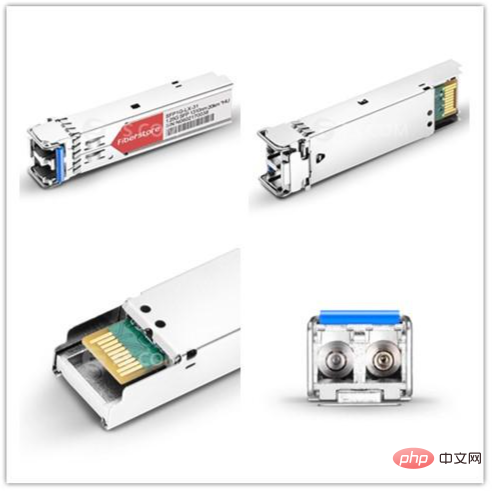Home >Common Problem >What is sfp optical module
What is sfp optical module
- 青灯夜游Original
- 2023-04-14 16:48:237094browse
SFP optical module is a hot-swappable small package module in SFP package. It is an interface device that converts gigabit electrical signals into optical signals. It is an industry standard small pluggable gigabit optical transceiver. All-in-one module. The SFP optical module has two ports: 1. SFP port, which is mainly plugged into network equipment such as switches, routers, and media converters to convert electrical signals into optical signals for transmission; 2. LC interface or RJ45 interface, which is mainly used to connect Optical fiber or network cable for data transmission.

The operating environment of this tutorial: Windows 7 system, Dell G3 computer.
What is sfp optical module
SFP is the abbreviation of SMALL FORM PLUGGABLE (small pluggable), which can be simply understood as GBIC updated version.
The SFP optical module is a hot-swappable small package module in SFP package. The maximum rate can reach 10.3G and the interface is LC. SFP optical modules are mainly composed of lasers. SFP classification can be divided into rate classification, wavelength classification, and mode classification.
The SFP optical module is an interface device that converts gigabit electrical signals into optical signals. It is an industry-standard small pluggable Gigabit optical transceiver integrated module. Both ends of the SFP optical module: One end is an SFP port, which is mainly plugged into network equipment such as switches, routers, and media converters to convert electrical signals into optical signals for transmission; the other end is an LC interface or RJ45 interface, which is mainly used to connect Optical fiber or network cable for data transmission.
Appearance structure:

SFP optical module classification:
Rate: 155M , 1.25G, 2.5G, 4.25G
Wavelength: short distance, medium distance, long distance
Transmission mode: electrical port, single mode (SM), multimode (MM)
Special type of SFP optical module:
BIDI-SFP: Single fiber bidirectional SFP, using WDM technology, sending and receiving in both directions Different center wavelengths, thereby realizing bidirectional transmission of optical signals through one optical fiber.
The BIDI optical module has only 1 port, which is filtered through the filter in the optical module to complete the transmission of 1310 optical signals and the reception of 1550nm optical signals at the same time, or vice versa. Therefore, BIDI optical modules must be used in pairs.
Copper SFP: Copper port SFP optical module, using SFP packaging form, copper port module, can support a maximum transmission distance of 100m (RJ45, Category 5 twisted pair as the transmission medium).
CWDM SFP: Using CWDM technology, optical signals of different wavelengths can be combined together through an external wavelength division multiplexer and transmitted through one optical fiber, thus saving optical fiber resources. At the same time, the receiving end needs to use a wavelength division multiplexer to decompose the complex optical signal. CWDM SFP optical modules are divided into 18 bands, from 1270nm to 1610nm, with an interval of 20nm between each two bands. Colors are generally used to distinguish optical modules of different bands.
DWDM SFP: It is a dense wavelength division multiplexing technology that can couple light of different wavelengths into a single-core fiber and transmit them together. The channel spacing of DWDM SFP is 0.4nm, 0.8nm, and 1.6nm as needed. Different intervals, smaller intervals require additional wavelength control devices. A key advantage of DWDM SFP is that it is protocol and transmission speed independent.
Precautions for using SFP optical module
SFP optical module installation:
SFP optical module removal:
Extended knowledge:
The difference between SFP port and RJ45 port
Although the maximum transmission rate of the SFP port and the RJ45 port is both 1000Mbps, there are some differences between the two.
1. Different applications
For example, the SFP port on the switch needs to be equipped with an SFP optical module and uses optical fiber jumpers to achieve data transmission; while the RJ45 port on the switch can directly achieve data transmission through network cables.
2. Different transmission distances
The RJ45 port mainly transmits data through the network cable, and its maximum transmission distance is the maximum transmission distance of the network cable, which is 100 meters; while the SFP port needs to be connected using an SFP optical module Optical fiber patch cord is used for transmission, and its maximum transmission distance is the maximum transmission distance of the SFP optical module, which is 160 meters.
Note: When using single-mode fiber (SMF) for shorter distances, in order to avoid overloading the receiver, an optical attenuator needs to be inserted into the link.
In addition, whether it is the port itself or the network equipment (such as a switch), SFP's flexibility, scalability and cost are higher than RJ45.
Can the SFP port be connected to the RJ45 port?
The answer is "yes". For example, if a 1G SFP switch is connected to a 1G RJ45 switch, we only need to use a Gigabit electrical port module on the 1G SFP switch to achieve the connection. Because the two ends of the Gigabit electrical port module: one end is an SFP port and the other end is an RJ45 interface. The SFP port is inserted into the 1G SFP switch, and then a network cable is used to connect the RJ45 interface of the Gigabit electrical port module and the RJ45 port of the 1G RJ45 switch. Can.
For more related knowledge, please visit the FAQ column!
The above is the detailed content of What is sfp optical module. For more information, please follow other related articles on the PHP Chinese website!
Related articles
See more- Is the 1.25g optical module a Gigabit module?
- Four lines of code to solve calculus in seconds! This Python module is amazing!
- Let's talk about Collections, a built-in module of Python
- Write a C++ extension module for Python
- Four steps to package a new Python module
- So practical! Schedule module, Python's periodic task artifact!





